Functional Programming and Haskell - TWBR Away Day 2011
1 like1,112 views
Explains why functional programming is back and shows some features from Haskell that are being ported to other languages. Presented at ThoughtWorks Brazil Away Day 2011.
1 of 34
Downloaded 16 times
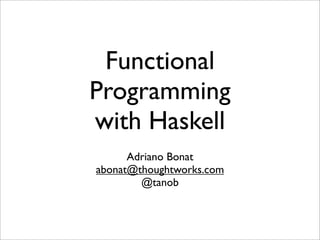
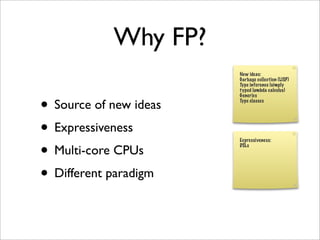
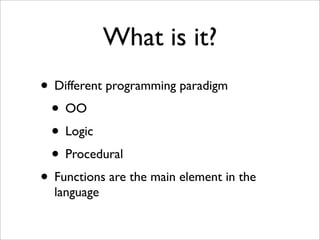
![Function applications
¡°Functional programming is so called because a
program consists entirely of functions. [...]
Typically the main function is de?ned in terms of other
functions, which in turn are de?ned in terms of still
more functions, until at the bottom level the functions
are language primitives.¡±
John Hughes, 1989 -Why functional programming matters](https://image.slidesharecdn.com/functionalprogrammingandhaskell-awayday-130705135420-phpapp02/85/Functional-Programming-and-Haskell-TWBR-Away-Day-2011-4-320.jpg)
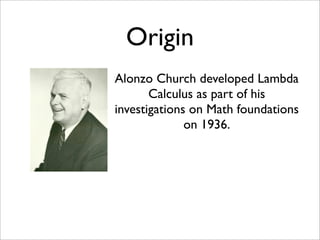
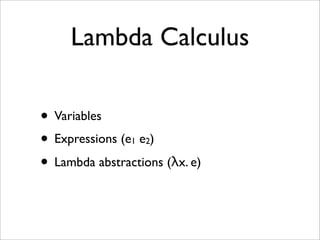
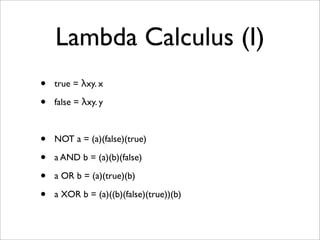
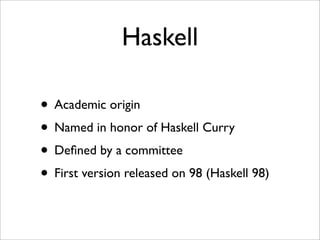
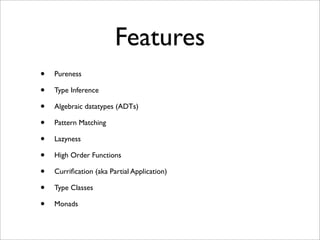
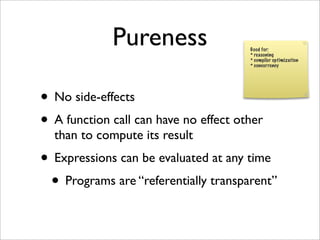
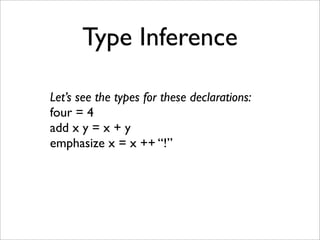
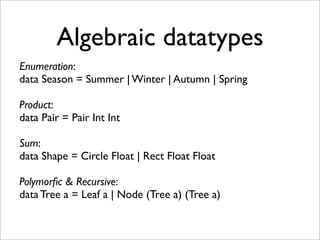
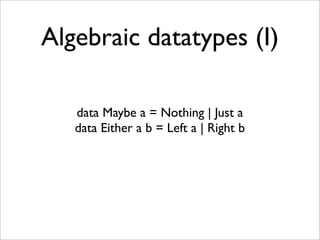
![Pattern Matching
De?nition:
sum [] = 0
sum (elem:rest) = elem + sum rest
Application:
sum [1,2,3,10]](https://image.slidesharecdn.com/functionalprogrammingandhaskell-awayday-130705135420-phpapp02/85/Functional-Programming-and-Haskell-TWBR-Away-Day-2011-14-320.jpg)
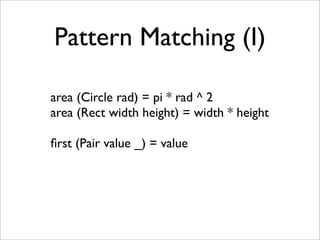
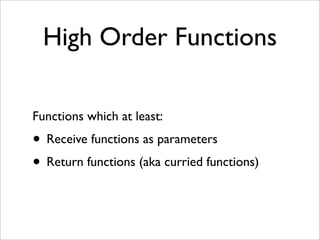
![High Order Functions (I)
map :: (a -> b) -> [a] -> [b]
map f [] = []
map f (x:xs) = f x : map f xs](https://image.slidesharecdn.com/functionalprogrammingandhaskell-awayday-130705135420-phpapp02/85/Functional-Programming-and-Haskell-TWBR-Away-Day-2011-17-320.jpg)
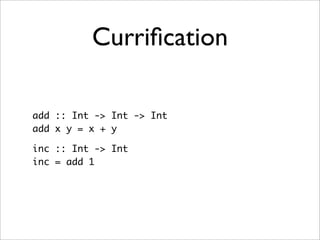
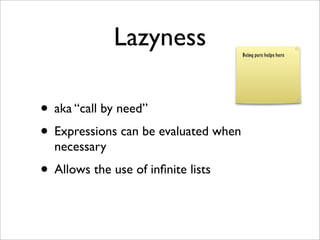
![Lazyness (I)
De?nition:
even_numbers :: [Int]
even_numbers = filter even [1..]
Application:
take 5 even_numbers](https://image.slidesharecdn.com/functionalprogrammingandhaskell-awayday-130705135420-phpapp02/85/Functional-Programming-and-Haskell-TWBR-Away-Day-2011-20-320.jpg)
![Lazyness (II)
fibs :: [Int]
fibs = 0 : 1 : zipWith (+) fibs (tail fibs)
From: http://en.wikipedia.org/wiki/Lazy_evaluation](https://image.slidesharecdn.com/functionalprogrammingandhaskell-awayday-130705135420-phpapp02/85/Functional-Programming-and-Haskell-TWBR-Away-Day-2011-21-320.jpg)
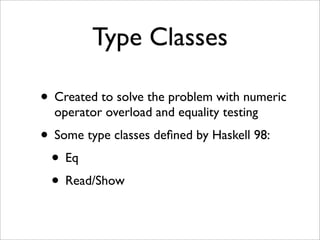
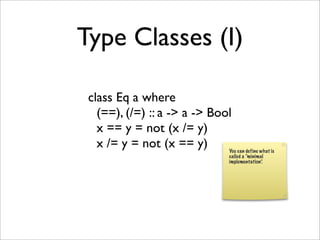
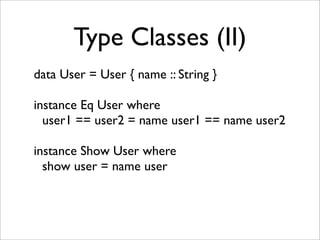
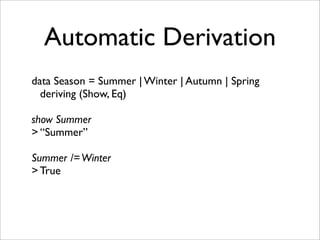
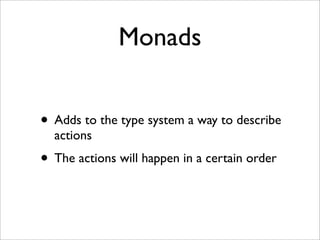
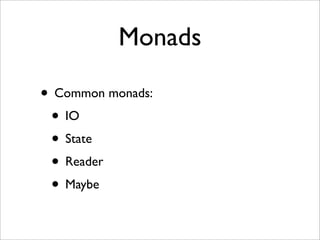
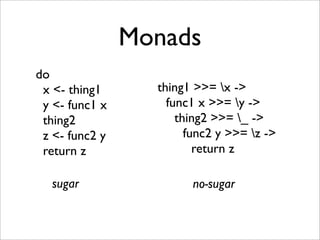
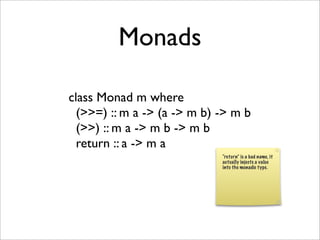
![Logger Monad
type Log = [String]
data Logger resultType = Logger (resultType, Log)
deriving Show
record x = Logger ((), [x])
instance Monad Logger where
return value = Logger (value, [])
prevLogger >>= nextAction =
let Logger (prevResult, prevLog) = prevLogger
Logger (newResult, newLog) = nextAction prevResult
in Logger (newResult, prevLog ++ newLog)](https://image.slidesharecdn.com/functionalprogrammingandhaskell-awayday-130705135420-phpapp02/85/Functional-Programming-and-Haskell-TWBR-Away-Day-2011-30-320.jpg)
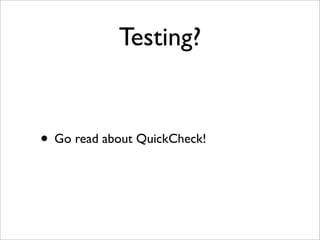
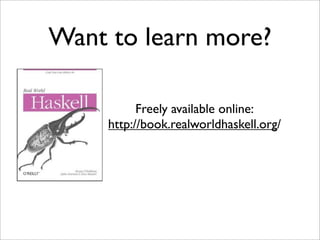
![Your Knowledge Portfolio
"Learn at least one new language every year.
[...] Different languages solve the same
problems in different ways. By learning several
different approaches, you can help broaden
your thinking and avoid getting stuck in a
rut."
The Pragmatic Programmer](https://image.slidesharecdn.com/functionalprogrammingandhaskell-awayday-130705135420-phpapp02/85/Functional-Programming-and-Haskell-TWBR-Away-Day-2011-33-320.jpg)
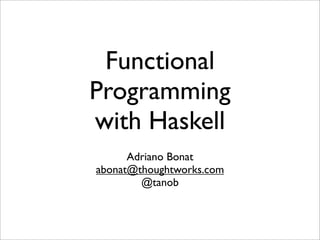
Recommended
How to use Map() Filter() and Reduce() functions in Python | Edureka



How to use Map() Filter() and Reduce() functions in Python | EdurekaEdureka!
?
Youtube Link: https://youtu.be/QxpbE5hDPws
** Python Certification Training: https://www.edureka.co/data-science-python-certification-course**
This Edureka PPT on 'map, filter, and reduce functions in Python' is to educate you about these very important built-in functions in Python. Below are the topics covered in this PPT:
Introduction to map filter reduce
The map() function
The filter() function
The reduce() function
Using map(),filter() and reduce() functions together
filter() within map()
map() within filter()
map() and filter() within reduce()
Follow us to never miss an update in the future.
YouTube: https://www.youtube.com/user/edurekaIN
Instagram: https://www.instagram.com/edureka_learning/
Facebook: https://www.facebook.com/edurekaIN/
Twitter: https://twitter.com/edurekain
LinkedIn: https://www.linkedin.com/company/edureka
Castbox: https://castbox.fm/networks/505?country=inMap filter reduce in Python



Map filter reduce in PythonAdnan Siddiqi
?
Map applies a function to each item in a list and returns a new list. Reduce applies a computation via a function to a list and returns a single result. Filter applies a condition to an iterator and returns a new iterator containing items that match the criteria. Together, map, filter and reduce allow programmers to write shorter Python programs without using loops.Why Haskell Matters



Why Haskell Mattersromanandreg
?
First presentation of the Vancouver Haskell Meetup. Here we introduce the capabilities of Haskell and some of it's main characteristics as a languageIntroduction to haskell



Introduction to haskellLuca Molteni
?
A simple introduction to Haskell during the 17/10/2015 Haskell ITA meetup in Bologna.
It shows basic Haskell concepts, currying and functors.Functional Programming in Swift



Functional Programming in SwiftSaugat Gautam
?
This slide contains short introduction to different elements of functional programming along with some specific techniques with which we use functional programming in Swift.Functional programming with haskell



Functional programming with haskellfaradjpour
?
This document provides an overview of functional programming with Haskell. It discusses key concepts of functional programming like immutable data structures and pure functions. It introduces Haskell types including basic types, tuples, lists, data types, and type classes. It covers Haskell functions like pattern matching, guards, and higher order functions. It also discusses Haskell concepts like laziness, currying, and polymorphism. Finally, it provides an introduction to monads in Haskell and discusses Haskell tools, frameworks, and performance.Map, Reduce and Filter in Swift



Map, Reduce and Filter in SwiftAleksandras Smirnovas
?
This document discusses functional programming concepts like map, reduce, and filter and provides Swift code examples for applying these concepts. It begins with an introduction to functional programming and key concepts. It then covers Swift basics like function types and passing functions. The bulk of the document explains and demonstrates map, reduce, filter and their uses on arrays and optionals in Swift. It concludes with suggestions for further functional programming topics and resources.Functional Programming by Examples using Haskell



Functional Programming by Examples using Haskellgoncharenko
?
The document discusses functional programming concepts in Haskell compared to traditional imperative languages like C++. It provides:
1) An example of quicksort implemented in both C++ and Haskell to illustrate the differences in approach and syntax between the two paradigms. The Haskell version is much more concise, using only 5 lines compared to 14 lines in C++.
2) Explanations of key functional programming concepts in Haskell including pure functions, recursion, pattern matching, and higher-order functions like map and fold.
3) Examples and definitions of commonly used Haskell functions and data types to summarize lists, sorting, and traversing elements - highlighting the more declarative style of functional programming.Reasoning about laziness



Reasoning about lazinessJohan Tibell
?
This document discusses reasoning about laziness in Haskell. It explains that functions and data constructors don't evaluate their arguments until needed. This laziness allows separating producers and consumers efficiently. However, laziness can also cause problems like space leaks from unevaluated thunks. The document demonstrates techniques like using seq, bang patterns and strict data types to control evaluation order and avoid space leaks. It also discusses how to determine which arguments a function evaluates strictly.Haskell for data science



Haskell for data scienceJohn Cant
?
ºÝºÝߣshare hasn't imported my notes, so here's the link to the Google Presentation: https://goo.gl/Gl4Vhm
Haskell is a statically typed, non strict, pure functional programming language. It is often talked and blogged about, but rarely used commercially. This talk starts with a brief overview of the language, then explains how Haskell is evaluated and how it deals with non-determinism and side effects using only pure functions. The suitability of Haskell for real world data science is then discussed, along with some examples of its users, a small Haskell-powered visualization, and an overview of useful packages for data science. Finally, Accelerate is introduced, an embedded DSL for array computations on the GPU, and an ongoing attempt to use it as the basis for a deep learning package.Beginning Haskell, Dive In, Its Not That Scary!



Beginning Haskell, Dive In, Its Not That Scary!priort
?
Haskell can get a bit of a reputation for being this lofty, academic, difficult to learn language. This talk aims to dispel this myth and offer an introduction to this beautiful and pragmatic language. From the point of view of someone who has been functional programming in Scala and Clojure for a while now, but who has, more recently been taking a dive into Haskell, this talk will give a basic introduction to Haskell. Hopefully it will encourage anyone who hasn't tried functional programming in Haskell to dive in too and give it a go.
The talk will be a whistle stop tour of some functional programming fundamentals in Haskell from basic data structures, logic constructs, functional transformations, recursion to some of the basics of Haskell's type system with data declarations and type classes.High-Performance Haskell



High-Performance HaskellJohan Tibell
?
This document provides a 3-sentence summary of the given document:
The document is a tutorial introduction to high-performance Haskell that covers topics like lazy evaluation, reasoning about space usage, benchmarking, profiling, and making Haskell code run faster. It explains concepts like laziness, thunks, and strictness and shows how to define tail-recursive functions, use foldl' for a strict left fold, and force evaluation of data constructor arguments to avoid space leaks. The goal is to help programmers optimize Haskell code and make efficient use of multiple processor cores.Functional Programming - Past, Present and Future



Functional Programming - Past, Present and FuturePushkar Kulkarni
?
Functional programming has evolved significantly since its origins in lambda calculus. Key developments include Lisp (1958), ML (1973), Haskell (1990), and more recently languages for the JVM like Scala (2004) and Clojure (2007). Functional concepts like immutable data, higher-order functions, lazy evaluation and currying allow a more declarative style and improved performance. Advances like tail call optimization and parallelism address early performance issues. Future areas include dependent types as in Idris and embracing functional principles in mainstream languages like Java 8. Functional programming changes how we think about solving problems.Functional ruby



Functional rubyKerry Buckley
?
Quickly cobbled-together slides for a short functional ruby talk at work (inspired by @threedaymonk's "Don't fear the lambda" at Ru3ymanor).Rewriting Java In Scala



Rewriting Java In ScalaSkills Matter
?
The document discusses how to rewrite Java code in Scala by taking advantage of Scala's functional programming features like case classes, pattern matching, filters, maps, folds, and generators to make the code more concise and readable. It provides examples of rewriting common Java constructs like filtering lists, mapping over lists, and reducing lists using these Scala features.Lec4



Lec4Nikhil Chilwant
?
The document discusses different data structures for implementing dictionaries, including arrays, linked lists, hash tables, binary trees, and B-trees. It focuses on hashing as a technique for implementing dictionaries. Hashing maps keys to table slots using a hash function to achieve fast average-case search, insertion, and deletion times of O(1). Collisions are resolved using chaining, where each slot contains a linked list. The load factor affects performance, with lower load factors resulting in faster operations.The Functional Programming Triad of Folding, Scanning and Iteration - a first...



The Functional Programming Triad of Folding, Scanning and Iteration - a first...Philip Schwarz
?
The document discusses implementing various functional programming concepts like folding, scanning, and iteration to solve problems involving converting between digit sequences and integers. It provides examples in Scala and Haskell of using fold left to implement a digits-to-integer function and the iterate function to implement an integer-to-digits function. It also discusses using techniques like pipes in Scala and the $ operator in Haskell to improve readability by ordering function applications in the sequence they will be executed.Functions in advanced programming



Functions in advanced programmingVisnuDharsini
?
The document discusses Python's built-in functions for functional programming: map(), filter(), reduce(), and lambda. It provides examples of using each function to transform sequences. Map applies a function to each item in a sequence. Filter filters items based on a function that tests each item. Reduce combines items via a function to produce a single value. These functions allow functional-style programming in Python.Seminar fp



Seminar fpVeerapatBoonvanich1
?
Functional programming is a programming paradigm that uses functions and avoids side effects, mutable data, and state changes. It is based on lambda calculus. Popular functional programming concepts include map, reduce, filter, take, drop, head, and tail. Functional programming languages like Haskell, ML, Scala, Clojure, and F# are used by companies like Twitter, Facebook, and Apache for applications involving big data processing.Maps&hash tables



Maps&hash tablesPriyanka Rana
?
Describes Map data structure, its methods and implementation using Hash tables & linked list along with their running time. Hash table components, bucket Array and hash function. Collision handing strategies: Separate chaining, Linear probing, quadratic probing, double hashing.
Ordered Maps and corresponding binary searchData structures



Data structuresSneha Chopra
?
This document provides an overview of different data structures and sorting algorithms. It begins with an introduction to data structures and describes linear data structures like arrays, stacks, queues, and linked lists as well as non-linear data structures like trees and graphs. It then provides more detailed descriptions of stacks, queues, linked lists, and common sorting algorithms like selection sort and bubble sort.Priority Queue



Priority QueueJoyjit Choudhury
?
The document discusses the C++ Standard Template Library priority queue, which provides constant-time access to the largest or smallest element while maintaining the heap property. A priority queue is a container adaptor that uses a heap to provide efficient insertion and extraction, allowing O(1) retrieval of the maximum or minimum element through top() and removal of the top element using pop(). It can be configured as a max or min heap using different comparators.Arrays In Python | Python Array Operations | Edureka



Arrays In Python | Python Array Operations | EdurekaEdureka!
?
** Python Certification Training: https://www.edureka.co/python **
This Edureka PPT on 'Arrays in Python' will help you establish a strong hold on all the fundamentals in the Python programming language. Below are the topics covered in this PPT:
What is an array?
Is python list same as an array?
How to create arrays in python?
Accessing array elements
Basic array operations
- Finding the length of an array
- Adding Elements
- Removing elements
- Array concatenation
- Slicing
- Looping
Python Tutorial Playlist: https://goo.gl/WsBpKe
Blog Series: http://bit.ly/2sqmP4s
Follow us to never miss an update in the future.
YouTube: https://www.youtube.com/user/edurekaIN
Instagram: https://www.instagram.com/edureka_learning/
Facebook: https://www.facebook.com/edurekaIN/
Twitter: https://twitter.com/edurekain
LinkedIn: https://www.linkedin.com/company/edureka
Lec5



Lec5Nikhil Chilwant
?
This document summarizes techniques for hashing, including hash functions, open addressing, linear probing, and double hashing. It discusses choosing good hash functions that distribute keys uniformly. For open addressing, it describes linear probing, which probes successive table locations when collisions occur, and double hashing, which uses two hash functions to determine probe positions. Analysis shows the expected number of probes is related to the load factor for these probing techniques.Gdg almaty. §¶§å§ß§Ü§è§Ú§à§ß§Ñ§Ý§î§ß§à§Ö §á§â§à§Ô§â§Ñ§Þ§Þ§Ú§â§à§Ó§Ñ§ß§Ú§Ö §Ó Java 8



Gdg almaty. §¶§å§ß§Ü§è§Ú§à§ß§Ñ§Ý§î§ß§à§Ö §á§â§à§Ô§â§Ñ§Þ§Þ§Ú§â§à§Ó§Ñ§ß§Ú§Ö §Ó Java 8Madina Kamzina
?
§° §æ§å§ß§Ü§è§Ú§à§ß§Ñ§Ý§î§ß§à§Þ §á§â§à§Ô§â§Ñ§Þ§Þ§Ú§â§à§Ó§Ñ§ß§Ú§Ú (§¶§±), §á§â§Ö§Ú§Þ§å§ë§Ö§ã§ä§Ó§Ñ§ç §Ö§Ô§à §Ú§ã§á§à§Ý§î§Ù§à§Ó§Ñ§ß§Ú§ñ §Ú §à §ä§à§Þ, §Ü§Ñ§Ü§Ú§Ö §Ó§à§Ù§Þ§à§Ø§ß§à§ã§ä§Ú §Õ§Ý§ñ §ß§Ö§Ô§à §Õ§à§Ò§Ñ§Ó§Ú§Ý§Ú §Ó §ß§à§Ó§à§Þ §â§Ö§Ý§Ú§Ù§Ö Java. §³§Ý§å§ê§Ñ§ä§Ö§Ý§Ú §ä§Ñ§Ü§Ø§Ö §å§Ù§ß§Ñ§ð§ä, §á§à§é§Ö§Þ§å §å§Ø§Ö §ã§Ö§Û§é§Ñ§ã §ã§ä§à§Ú§ä §ß§Ñ§é§Ñ§ä§î §Ú§Ù§å§é§Ñ§ä§î §¶§±.
§®§Ú§ä§Ñ§á §ã§à§ã§ä§à§ñ§Ý§ã§ñ ->> https://plus.google.com/u/0/b/100893943920756626864/events/c0b2b1ih9ft0opcdnmdgp3453rkAlgorithms: I



Algorithms: IJoyjit Choudhury
?
The document discusses algorithms in the C++ Standard Template Library (STL), focusing on the sort algorithm. It explains that algorithms perform operations on containers and sequences, and are collected in headers like <algorithm> and <numeric>. The sort algorithm sorts elements in a range using < or a binary predicate compare function. The binary predicate decides the relative ordering of elements after each comparison. Structs or templates can also be used to define generic binary predicates for sorting different data types.Arrays.pptx



Arrays.pptxShweta Bhatia
?
This document discusses arrays and stacks. It includes examples of declaring and initializing one-dimensional and two-dimensional arrays in pseudocode. It shows how to insert values into an array using a loop, access individual elements, and find the maximum value in an array. It also defines what a stack is, how it follows the LIFO principle, and provides an example of reversing a string using a stack in pseudocode.Collections In Scala



Collections In ScalaKnoldus Inc.
?
This document discusses Scala collections. It provides an introduction to Scala collections and code examples of using various collection types like lists, sets, tuples, maps, and options. It also covers functional combinators that can be used on collections, such as map, filter, foldLeft, and flatten.Functional Programming Past Present Future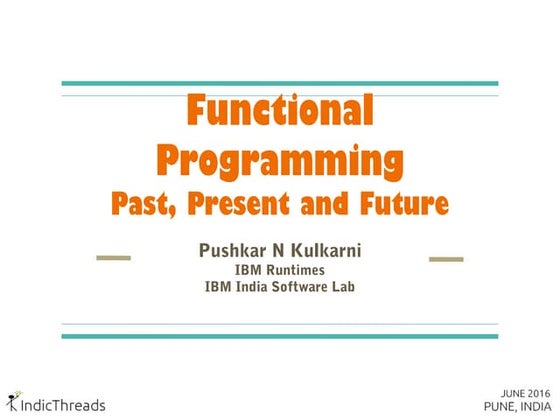



Functional Programming Past Present FutureIndicThreads
?
Presented at the IndicThreads.com Software Development Conference 2016 held in Pune, India. More at http://www.IndicThreads.com and http://Pune16.IndicThreads.com
--Introduction to Functional Programming



Introduction to Functional ProgrammingFrancesco Bruni
?
A brief introduction to functional programming.
Even if slides present some simple Python code, functional programming patterns applies to other languages too.More Related Content
What's hot (20)
Reasoning about laziness



Reasoning about lazinessJohan Tibell
?
This document discusses reasoning about laziness in Haskell. It explains that functions and data constructors don't evaluate their arguments until needed. This laziness allows separating producers and consumers efficiently. However, laziness can also cause problems like space leaks from unevaluated thunks. The document demonstrates techniques like using seq, bang patterns and strict data types to control evaluation order and avoid space leaks. It also discusses how to determine which arguments a function evaluates strictly.Haskell for data science



Haskell for data scienceJohn Cant
?
ºÝºÝߣshare hasn't imported my notes, so here's the link to the Google Presentation: https://goo.gl/Gl4Vhm
Haskell is a statically typed, non strict, pure functional programming language. It is often talked and blogged about, but rarely used commercially. This talk starts with a brief overview of the language, then explains how Haskell is evaluated and how it deals with non-determinism and side effects using only pure functions. The suitability of Haskell for real world data science is then discussed, along with some examples of its users, a small Haskell-powered visualization, and an overview of useful packages for data science. Finally, Accelerate is introduced, an embedded DSL for array computations on the GPU, and an ongoing attempt to use it as the basis for a deep learning package.Beginning Haskell, Dive In, Its Not That Scary!



Beginning Haskell, Dive In, Its Not That Scary!priort
?
Haskell can get a bit of a reputation for being this lofty, academic, difficult to learn language. This talk aims to dispel this myth and offer an introduction to this beautiful and pragmatic language. From the point of view of someone who has been functional programming in Scala and Clojure for a while now, but who has, more recently been taking a dive into Haskell, this talk will give a basic introduction to Haskell. Hopefully it will encourage anyone who hasn't tried functional programming in Haskell to dive in too and give it a go.
The talk will be a whistle stop tour of some functional programming fundamentals in Haskell from basic data structures, logic constructs, functional transformations, recursion to some of the basics of Haskell's type system with data declarations and type classes.High-Performance Haskell



High-Performance HaskellJohan Tibell
?
This document provides a 3-sentence summary of the given document:
The document is a tutorial introduction to high-performance Haskell that covers topics like lazy evaluation, reasoning about space usage, benchmarking, profiling, and making Haskell code run faster. It explains concepts like laziness, thunks, and strictness and shows how to define tail-recursive functions, use foldl' for a strict left fold, and force evaluation of data constructor arguments to avoid space leaks. The goal is to help programmers optimize Haskell code and make efficient use of multiple processor cores.Functional Programming - Past, Present and Future



Functional Programming - Past, Present and FuturePushkar Kulkarni
?
Functional programming has evolved significantly since its origins in lambda calculus. Key developments include Lisp (1958), ML (1973), Haskell (1990), and more recently languages for the JVM like Scala (2004) and Clojure (2007). Functional concepts like immutable data, higher-order functions, lazy evaluation and currying allow a more declarative style and improved performance. Advances like tail call optimization and parallelism address early performance issues. Future areas include dependent types as in Idris and embracing functional principles in mainstream languages like Java 8. Functional programming changes how we think about solving problems.Functional ruby



Functional rubyKerry Buckley
?
Quickly cobbled-together slides for a short functional ruby talk at work (inspired by @threedaymonk's "Don't fear the lambda" at Ru3ymanor).Rewriting Java In Scala



Rewriting Java In ScalaSkills Matter
?
The document discusses how to rewrite Java code in Scala by taking advantage of Scala's functional programming features like case classes, pattern matching, filters, maps, folds, and generators to make the code more concise and readable. It provides examples of rewriting common Java constructs like filtering lists, mapping over lists, and reducing lists using these Scala features.Lec4



Lec4Nikhil Chilwant
?
The document discusses different data structures for implementing dictionaries, including arrays, linked lists, hash tables, binary trees, and B-trees. It focuses on hashing as a technique for implementing dictionaries. Hashing maps keys to table slots using a hash function to achieve fast average-case search, insertion, and deletion times of O(1). Collisions are resolved using chaining, where each slot contains a linked list. The load factor affects performance, with lower load factors resulting in faster operations.The Functional Programming Triad of Folding, Scanning and Iteration - a first...



The Functional Programming Triad of Folding, Scanning and Iteration - a first...Philip Schwarz
?
The document discusses implementing various functional programming concepts like folding, scanning, and iteration to solve problems involving converting between digit sequences and integers. It provides examples in Scala and Haskell of using fold left to implement a digits-to-integer function and the iterate function to implement an integer-to-digits function. It also discusses using techniques like pipes in Scala and the $ operator in Haskell to improve readability by ordering function applications in the sequence they will be executed.Functions in advanced programming



Functions in advanced programmingVisnuDharsini
?
The document discusses Python's built-in functions for functional programming: map(), filter(), reduce(), and lambda. It provides examples of using each function to transform sequences. Map applies a function to each item in a sequence. Filter filters items based on a function that tests each item. Reduce combines items via a function to produce a single value. These functions allow functional-style programming in Python.Seminar fp



Seminar fpVeerapatBoonvanich1
?
Functional programming is a programming paradigm that uses functions and avoids side effects, mutable data, and state changes. It is based on lambda calculus. Popular functional programming concepts include map, reduce, filter, take, drop, head, and tail. Functional programming languages like Haskell, ML, Scala, Clojure, and F# are used by companies like Twitter, Facebook, and Apache for applications involving big data processing.Maps&hash tables



Maps&hash tablesPriyanka Rana
?
Describes Map data structure, its methods and implementation using Hash tables & linked list along with their running time. Hash table components, bucket Array and hash function. Collision handing strategies: Separate chaining, Linear probing, quadratic probing, double hashing.
Ordered Maps and corresponding binary searchData structures



Data structuresSneha Chopra
?
This document provides an overview of different data structures and sorting algorithms. It begins with an introduction to data structures and describes linear data structures like arrays, stacks, queues, and linked lists as well as non-linear data structures like trees and graphs. It then provides more detailed descriptions of stacks, queues, linked lists, and common sorting algorithms like selection sort and bubble sort.Priority Queue



Priority QueueJoyjit Choudhury
?
The document discusses the C++ Standard Template Library priority queue, which provides constant-time access to the largest or smallest element while maintaining the heap property. A priority queue is a container adaptor that uses a heap to provide efficient insertion and extraction, allowing O(1) retrieval of the maximum or minimum element through top() and removal of the top element using pop(). It can be configured as a max or min heap using different comparators.Arrays In Python | Python Array Operations | Edureka



Arrays In Python | Python Array Operations | EdurekaEdureka!
?
** Python Certification Training: https://www.edureka.co/python **
This Edureka PPT on 'Arrays in Python' will help you establish a strong hold on all the fundamentals in the Python programming language. Below are the topics covered in this PPT:
What is an array?
Is python list same as an array?
How to create arrays in python?
Accessing array elements
Basic array operations
- Finding the length of an array
- Adding Elements
- Removing elements
- Array concatenation
- Slicing
- Looping
Python Tutorial Playlist: https://goo.gl/WsBpKe
Blog Series: http://bit.ly/2sqmP4s
Follow us to never miss an update in the future.
YouTube: https://www.youtube.com/user/edurekaIN
Instagram: https://www.instagram.com/edureka_learning/
Facebook: https://www.facebook.com/edurekaIN/
Twitter: https://twitter.com/edurekain
LinkedIn: https://www.linkedin.com/company/edureka
Lec5



Lec5Nikhil Chilwant
?
This document summarizes techniques for hashing, including hash functions, open addressing, linear probing, and double hashing. It discusses choosing good hash functions that distribute keys uniformly. For open addressing, it describes linear probing, which probes successive table locations when collisions occur, and double hashing, which uses two hash functions to determine probe positions. Analysis shows the expected number of probes is related to the load factor for these probing techniques.Gdg almaty. §¶§å§ß§Ü§è§Ú§à§ß§Ñ§Ý§î§ß§à§Ö §á§â§à§Ô§â§Ñ§Þ§Þ§Ú§â§à§Ó§Ñ§ß§Ú§Ö §Ó Java 8



Gdg almaty. §¶§å§ß§Ü§è§Ú§à§ß§Ñ§Ý§î§ß§à§Ö §á§â§à§Ô§â§Ñ§Þ§Þ§Ú§â§à§Ó§Ñ§ß§Ú§Ö §Ó Java 8Madina Kamzina
?
§° §æ§å§ß§Ü§è§Ú§à§ß§Ñ§Ý§î§ß§à§Þ §á§â§à§Ô§â§Ñ§Þ§Þ§Ú§â§à§Ó§Ñ§ß§Ú§Ú (§¶§±), §á§â§Ö§Ú§Þ§å§ë§Ö§ã§ä§Ó§Ñ§ç §Ö§Ô§à §Ú§ã§á§à§Ý§î§Ù§à§Ó§Ñ§ß§Ú§ñ §Ú §à §ä§à§Þ, §Ü§Ñ§Ü§Ú§Ö §Ó§à§Ù§Þ§à§Ø§ß§à§ã§ä§Ú §Õ§Ý§ñ §ß§Ö§Ô§à §Õ§à§Ò§Ñ§Ó§Ú§Ý§Ú §Ó §ß§à§Ó§à§Þ §â§Ö§Ý§Ú§Ù§Ö Java. §³§Ý§å§ê§Ñ§ä§Ö§Ý§Ú §ä§Ñ§Ü§Ø§Ö §å§Ù§ß§Ñ§ð§ä, §á§à§é§Ö§Þ§å §å§Ø§Ö §ã§Ö§Û§é§Ñ§ã §ã§ä§à§Ú§ä §ß§Ñ§é§Ñ§ä§î §Ú§Ù§å§é§Ñ§ä§î §¶§±.
§®§Ú§ä§Ñ§á §ã§à§ã§ä§à§ñ§Ý§ã§ñ ->> https://plus.google.com/u/0/b/100893943920756626864/events/c0b2b1ih9ft0opcdnmdgp3453rkAlgorithms: I



Algorithms: IJoyjit Choudhury
?
The document discusses algorithms in the C++ Standard Template Library (STL), focusing on the sort algorithm. It explains that algorithms perform operations on containers and sequences, and are collected in headers like <algorithm> and <numeric>. The sort algorithm sorts elements in a range using < or a binary predicate compare function. The binary predicate decides the relative ordering of elements after each comparison. Structs or templates can also be used to define generic binary predicates for sorting different data types.Arrays.pptx



Arrays.pptxShweta Bhatia
?
This document discusses arrays and stacks. It includes examples of declaring and initializing one-dimensional and two-dimensional arrays in pseudocode. It shows how to insert values into an array using a loop, access individual elements, and find the maximum value in an array. It also defines what a stack is, how it follows the LIFO principle, and provides an example of reversing a string using a stack in pseudocode.Collections In Scala



Collections In ScalaKnoldus Inc.
?
This document discusses Scala collections. It provides an introduction to Scala collections and code examples of using various collection types like lists, sets, tuples, maps, and options. It also covers functional combinators that can be used on collections, such as map, filter, foldLeft, and flatten.Similar to Functional Programming and Haskell - TWBR Away Day 2011 (20)
Functional Programming Past Present Future



Functional Programming Past Present FutureIndicThreads
?
Presented at the IndicThreads.com Software Development Conference 2016 held in Pune, India. More at http://www.IndicThreads.com and http://Pune16.IndicThreads.com
--Introduction to Functional Programming



Introduction to Functional ProgrammingFrancesco Bruni
?
A brief introduction to functional programming.
Even if slides present some simple Python code, functional programming patterns applies to other languages too.Functional Programming Patterns (BuildStuff '14)



Functional Programming Patterns (BuildStuff '14)Scott Wlaschin
?
(video of these slides available here http://fsharpforfunandprofit.com/fppatterns/)
In object-oriented development, we are all familiar with design patterns such as the Strategy pattern and Decorator pattern, and design principles such as SOLID.
The functional programming community has design patterns and principles as well.
This talk will provide an overview of some of these, and present some demonstrations of FP design in practice.An Introduction to Functional Programming using Haskell



An Introduction to Functional Programming using HaskellMichel Rijnders
?
The document provides an introduction to functional programming using Haskell. It discusses Haskell's main features such as being purely functional, lazy, strongly typed, and supporting higher-order functions. It also covers Haskell's history, types, functions, pattern matching, and common data structures like lists. Programming techniques like recursion, algebraic data types, and type classes are explained. Examples of list processing functions and higher-order functions are provided.Functional Programming #FTW



Functional Programming #FTWAdriano Bonat
?
An introduction to the basic concepts on functional programming, explaining why it is a hot topic for some years now, what it is and some suggestions of functional languages to be learned.Java/Scala Lab: §¡§ß§Ñ§ä§à§Ý§Ú§Û §¬§Þ§Ö§ä§ð§Ü - Scala SubScript: §¡§Ý§Ô§Ö§Ò§â§Ñ §Õ§Ý§ñ §â§Ö§Ñ§Ü§ä§Ú§Ó§ß§à§Ô§à §á§â...



Java/Scala Lab: §¡§ß§Ñ§ä§à§Ý§Ú§Û §¬§Þ§Ö§ä§ð§Ü - Scala SubScript: §¡§Ý§Ô§Ö§Ò§â§Ñ §Õ§Ý§ñ §â§Ö§Ñ§Ü§ä§Ú§Ó§ß§à§Ô§à §á§â...GeeksLab Odessa
?
SubScript - §ï§ä§à §â§Ñ§ã§ê§Ú§â§Ö§ß§Ú§Ö §ñ§Ù§í§Ü§Ñ Scala, §Õ§à§Ò§Ñ§Ó§Ý§ñ§ð§ë§Ö§Ö §á§à§Õ§Õ§Ö§â§Ø§Ü§å §Ü§à§ß§ã§ä§â§å§Ü§è§Ú§Û §Ú §ã§Ú§ß§ä§Ñ§Ü§ã§Ú§ã§Ñ §Ñ§Ô§Ý§Ö§Ò§â§í §à§Ò§ë§Ñ§ð§ë§Ú§ç§ã§ñ §á§â§à§è§Ö§ã§ã§à§Ó (Algebra of Communicating Processes, ACP). SubScript §ñ§Ó§Ý§ñ§Ö§ä§ã§ñ §á§Ö§â§ã§á§Ö§Ü§ä§Ú§Ó§ß§í§Þ §â§Ñ§ã§ê§Ú§â§Ö§ß§Ú§Ö§Þ, §á§â§Ú§Þ§Ö§ß§Ú§Þ§í§Þ §Ü§Ñ§Ü §Õ§Ý§ñ §â§Ñ§Ù§â§Ñ§Ò§à§ä§Ü§Ú §Ó§í§ã§à§Ü§à§ß§Ñ§Ô§â§å§Ø§Ö§ß§ß§í§ç §á§Ñ§â§Ñ§Ý§Ý§Ö§Ý§î§ß§í§ç §ã§Ú§ã§ä§Ö§Þ, §ä§Ñ§Ü §Ú §Õ§Ý§ñ §á§â§à§ã§ä§í§ç §á§Ö§â§ã§à§ß§Ñ§Ý§î§ß§í§ç §á§â§Ú§Ý§à§Ø§Ö§ß§Ú§Û.INTRODUCTION TO LISP



INTRODUCTION TO LISPNilt1234
?
Here is a recursive function to check if a list contains an element:
(defun contains (element list)
(cond ((null list) nil)
((equal element (car list)) t)
(t (contains element (cdr list)))))
To check the guest list:
(contains 'robocop guest-list)
This function:
1. Base case: If list is empty, element is not contained - return nil
2. Check if element equals car of list - if so, return t
3. Otherwise, recursively call contains on element and cdr of list
So it will recursively traverse the list until it finds a match or reaches empty list.The Fuss about || Haskell | Scala | F# ||



The Fuss about || Haskell | Scala | F# ||Ashwin Rao
?
The document discusses functional programming languages Haskell, Scala, and F# and their advantages over imperative programming. It notes they encourage a different problem-solving approach using concepts like immutable values, recursion, and avoiding side effects. Specific features highlighted include static typing with type inference, algebraic data types, pattern matching, and monads for controlling program flow and errors in a functional way. Examples show equivalent algorithms in different languages to demonstrate these concepts.L4 functions



L4 functionsmondalakash2012
?
The document discusses functions in C programming. It begins by explaining what functions are and why they are useful. Functions help modularize programs, avoid code repetition, and allow for software reusability. Key benefits of using functions include divide and conquer programming and abstraction. The document then provides examples of function definitions, prototypes, parameters, return values, and scope. It also discusses calling functions, libraries, recursion, and other concepts related to functions in C.Five Languages in a Moment



Five Languages in a MomentSergio Gil
?
The document discusses 5 programming languages that the author has learned over the years: Ruby, Erlang, Haskell, Common Lisp, and Clojure. For each language, it provides a brief overview of its origins, paradigms, and interesting features. It encourages readers to try the languages if they are interested in functional programming, parallelism, strong typing, metaprogramming, or Lisp dialects on the JVM.Monads and Monoids by Oleksiy Dyagilev



Monads and Monoids by Oleksiy DyagilevJavaDayUA
?
Monads and Monoids: from daily java to Big Data analytics in Scala
Finally, after two decades of evolution, Java 8 made a step towards functional programming. What can Java learn from other mature functional languages? How to leverage obscure mathematical abstractions such as Monad or Monoid in practice? Usually people find it scary and difficult to understand. Oleksiy will explain these concepts in simple words to give a feeling of powerful tool applicable in many domains, from daily Java and Scala routines to Big Data analytics with Storm or Hadoop.TI1220 Lecture 6: First-class Functions



TI1220 Lecture 6: First-class FunctionsEelco Visser
?
This document discusses first-class functions and lambda calculus. It begins with an overview of Alonzo Church and the origins of lambda calculus. It then covers first-class functions in JavaScript, functions as objects in Java, and first-class functions in Scala. The document also discusses generic higher-order functions and control abstraction.Munihac 2018 - Beautiful Template Haskell



Munihac 2018 - Beautiful Template HaskellMatthew Pickering
?
Forget everything you know about Template Haskell. We will enter the beautiful world of Typed Template Haskell where its only possible to construct well-scoped and well-typed terms. Why? By writing our program in multiple stages, we can guarantee to eliminate the interpretative overhead caused by abstraction.
Matthew will give an introduction to Typed Template Haskell and then describe some examples of how to construct abstract and efficient programs using techniques from multi-stage programming. We will construct an "efficient" power function and also give a sketch of how to implement a SQL query compiler as inspired by the functional pearl "A SQL to C Compiler in 500 Lines of Code".
Matthew is a PhD student at the University of Bristol focusing on program generation with applications to optimisation. In the quest to write the perfect program he has become a regular contributor to GHC where he has recently been working on making the compiler easier to extend by using source plugins.10. haskell Modules



10. haskell ModulesSebastian Rettig
?
A Haskell module is a collection of related functions, types and typeclasses. Modules allow organizing code into namespaces and provide a way to selectively import functionality from other modules. Some key points about modules include:
- Modules manage types and functions into namespaces
- The main module can load other modules
- Modules are imported at the top of a file using import statements
- Functions and types can be selectively imported from a module
- Modules in the same parent folder can be in the same namespaceMonads in Swift



Monads in SwiftVincent Pradeilles
?
This document discusses monads in functional programming. It provides examples of optionals, arrays, and functions in Swift that exhibit monadic properties. It then defines monads more formally and describes some common monad types like the writer, reader, and IO monads. It shows how monads allow encapsulating effects like logging or environment variables while preserving referential transparency. The document concludes by discussing potential applications of monads to mobile apps.Functional Scala



Functional ScalaStan Lea
?
Programs are composed from a series of computation steps. Standardizing those steps and how they are chained simplifies both the development and maintenance of applications.
Monads are the abstractions that help do just that. Functions are all one needs a computation building blocks, as they can be lifted to abstractions that hide complexity.
Python Basics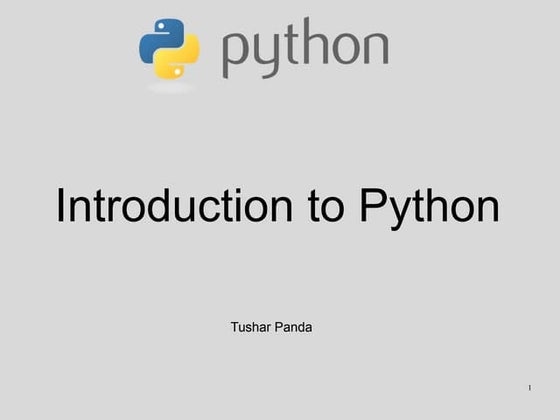



Python Basicstusharpanda88
?
This document provides an introduction to the Python programming language. It covers Python's background, syntax, types, operators, control flow, functions, classes, tools, and IDEs. Key points include that Python is a multi-purpose, object-oriented language that is interpreted, strongly and dynamically typed. It focuses on readability and has a huge library of modules. Popular Python IDEs include Emacs, Vim, Komodo, PyCharm, and Eclipse.Yin Yangs of Software Development



Yin Yangs of Software DevelopmentNaveenkumar Muguda
?
This document discusses various Yin-Yang concepts in software development, including:
- Effort and knowledge, theory and practice, design for manufacturing and design for assembly represent opposing yet interconnected concepts.
- Programs (E-programs) built on simpler programs (S-programs) balance ease of use and performance.
- Designing for both short-term efficiency and long-term evolvability requires balancing opposing priorities.
- Many software development processes involve balancing logical thinking with creative control, and reducing complexity through modularity.How to start functional programming (in Scala): Day1



How to start functional programming (in Scala): Day1Taisuke Oe
?
Functional programming involves composing computations like functions in a modular way. Scala supports both functional and object-oriented paradigms. Functions in Scala can be composed through methods like andThen and compose. Higher order functions allow functions to take other functions as arguments or return values. Pure functions always return the same output for the same inputs and avoid side effects. The Monoid typeclass abstracts the concepts of combining elements of a type and providing a default value, allowing new folding behaviors to be defined for types through implicit values. This allows behaviors to be extended to existing types without modifying them.Java/Scala Lab: §¡§ß§Ñ§ä§à§Ý§Ú§Û §¬§Þ§Ö§ä§ð§Ü - Scala SubScript: §¡§Ý§Ô§Ö§Ò§â§Ñ §Õ§Ý§ñ §â§Ö§Ñ§Ü§ä§Ú§Ó§ß§à§Ô§à §á§â...



Java/Scala Lab: §¡§ß§Ñ§ä§à§Ý§Ú§Û §¬§Þ§Ö§ä§ð§Ü - Scala SubScript: §¡§Ý§Ô§Ö§Ò§â§Ñ §Õ§Ý§ñ §â§Ö§Ñ§Ü§ä§Ú§Ó§ß§à§Ô§à §á§â...GeeksLab Odessa
?
Recently uploaded (20)
A General introduction to Ad ranking algorithms



A General introduction to Ad ranking algorithmsBuhwan Jeong
?
Details of AD ranking algorithms and beyondDev Dives: Unleash the power of macOS Automation with UiPath



Dev Dives: Unleash the power of macOS Automation with UiPathUiPathCommunity
?
Join us on March 27 to be among the first to explore UiPath innovative macOS automation capabilities.
This is a must-attend session for developers eager to unlock the full potential of automation.
? This webinar will offer insights on:
How to design, debug, and run automations directly on your Mac using UiPath Studio Web and UiPath Assistant for Mac.
We¡¯ll walk you through local debugging on macOS, working with native UI elements, and integrating with key tools like Excel on Mac.
This is a must-attend session for developers eager to unlock the full potential of automation.
??? Speakers:
Andrei Oros, Product Management Director @UiPath
SIlviu Tanasie, Senior Product Manager @UiPathGetting the Best of TrueDEM ¨C April News & Updates



Getting the Best of TrueDEM ¨C April News & Updatespanagenda
?
Webinar Recording: https://www.panagenda.com/webinars/getting-the-best-of-truedem-april-news-updates/
Boost your Microsoft 365 experience with OfficeExpert TrueDEM! Join the April webinar for a deep dive into recent and upcoming features and functionalities of OfficeExpert TrueDEM. We¡¯ll showcase what¡¯s new and use practical application examples and real-life scenarios, to demonstrate how to leverage TrueDEM to optimize your M365 environment, troubleshoot issues, improve user satisfaction and productivity, and ultimately make data-driven business decisions.
These sessions will be led by our team of product management and consultants, who interact with customers daily and possess in-depth product knowledge, providing valuable insights and expert guidance.
What you¡¯ll take away
- Updates & info about the latest and upcoming features of TrueDEM
- Practical and realistic applications & examples for troubelshooting or improving your Microsoft Teams & M365 environment
- Use cases and examples of how our customers use TrueDEMºÝºÝߣs from Perth MuleSoft Meetup March 2025



ºÝºÝߣs from Perth MuleSoft Meetup March 2025Michael Price
?
Revolutionizing Healthcare Interoperability with MuleSoft
plus
MuleSoft Agentforce and GenAISmarter RAG Pipelines: Scaling Search with Milvus and Feast



Smarter RAG Pipelines: Scaling Search with Milvus and FeastZilliz
?
About this webinar
Learn how Milvus and Feast can be used together to scale vector search and easily declare views for retrieval using open source. We¡¯ll demonstrate how to integrate Milvus with Feast to build a customized RAG pipeline.
Topics Covered
- Leverage Feast for dynamic metadata and document storage and retrieval, ensuring that the correct data is always available at inference time
- Learn how to integrate Feast with Milvus to support vector-based retrieval in RAG systems
- Use Milvus for fast, high-dimensional similarity search, enhancing the retrieval phase of your RAG modelDragino¥×¥í¥À¥¯¥È¥«¥¿¥í¥° LoRaWAN NB-IoT LTE cat.M1ÉÌÆ·¥ê¥¹¥È



Dragino¥×¥í¥À¥¯¥È¥«¥¿¥í¥° LoRaWAN NB-IoT LTE cat.M1ÉÌÆ·¥ê¥¹¥ÈCRI Japan, Inc.
?
Dragino¥×¥í¥À¥¯¥È¥«¥¿¥í¥° LoRaWAN NB-IoT LTE cat.M1ÉÌÆ·¥ê¥¹¥ÈJava on AWS Without the Headaches - Fast Builds, Cheap Deploys, No Kubernetes



Java on AWS Without the Headaches - Fast Builds, Cheap Deploys, No KubernetesVictorSzoltysek
?
Java Apps on AWS Without the Headaches: Fast Builds, Cheap Deploys, No Kubernetes
Let¡¯s face it: the cloud has gotten out of hand. What used to be simple¡ªdeploying your Java app¡ªhas become a maze of slow builds, tedious deploys, and eye-watering AWS bills. But here¡¯s the thing: it doesn¡¯t have to be this way. Every minute you spend waiting on builds or wrestling with unnecessary cloud complexity is a minute you¡¯re not building the features your customers actually care about.
In this talk, I¡¯ll show you how to go from a shiny new Java app to production in under 10 minutes¡ªwith fast builds, cheap deploys, and zero downtime. We¡¯ll go deep into optimizing builds with Gradle (it¡¯s time to leave Maven in the dust), parallelization strategies, and smarter caching mechanics that make your CI/CD pipelines fly. From there, we¡¯ll review the dozen+ ways AWS lets you deploy apps and cut through the chaos to find the solutions that work best for lean, fast, cost-effective pipelines. Spoiler: ECS and EKS usually aren¡¯t the answer. Oh, and I¡¯ll even show you how AI tools like AWS Bedrock can help streamline your processes further, so you can automate what should already be automatic.
This talk is for developers fed up with the cost, complexity, and friction of modern cloud setups¡ªor those who long for the simplicity of the Heroku/Beanstalk/PCF days when deploying to the cloud wasn¡¯t a headache. Whether you¡¯re on AWS, Azure, or GCP, you¡¯ll learn actionable, cloud-agnostic tips to build faster, deploy cheaper, and refocus on what matters most: delivering value to your users.CIOs Speak Out - A Research Series by Jasper Colin



CIOs Speak Out - A Research Series by Jasper ColinJasper Colin
?
Discover key IT leadership insights from top CIOs on AI, cybersecurity, and cost optimization. Jasper Colin¡¯s research reveals what¡¯s shaping the future of enterprise technology. Stay ahead of the curve.How Air Coil Inductors Work By Cet Technology



How Air Coil Inductors Work By Cet TechnologyCET Technology
?
Air coil inductors are coils of conducting wire wound around a non-magnetic core, typically plastic, ceramic, or an air-filled form. These inductors don't rely on a magnetic core made of permeable materials like traditional inductors. The coil consists of a wire wound around a non-magnetic form, where air is the primary medium between the windings.Build with AI on Google Cloud Session #5



Build with AI on Google Cloud Session #5Margaret Maynard-Reid
?
This is session #5 of the 5-session online study series with Google Cloud, where we take you onto the journey learning generative AI. You¡¯ll explore the dynamic landscape of Generative AI, gaining both theoretical insights and practical know-how of Google Cloud GenAI tools such as Gemini, Vertex AI, AI agents and Imagen 3. Rene-Peinado-A-Maritime-Professionals-Journey---.pptx



Rene-Peinado-A-Maritime-Professionals-Journey---.pptxRene Peinado
?
Explore my 30+ years in the maritime industry, from tanker operations to shipbuilding and offshore innovations. Learn how strategic management and advanced technologies shape modern maritime solutions.Testing Tools for Accessibility Enhancement Part II.pptx



Testing Tools for Accessibility Enhancement Part II.pptxJulia Undeutsch
?
Automatic Testing Tools will help you get a first understanding of the accessibility of your website or web application. If you are new to accessibility, it will also help you learn more about the topic and the different issues that are occurring on the web when code is not properly written.Packaging your App for AppExchange ¨C Managed Vs Unmanaged.pptx



Packaging your App for AppExchange ¨C Managed Vs Unmanaged.pptxmohayyudin7826
?
Learn how to package your app for Salesforce AppExchange with a deep dive into managed vs. unmanaged packages. Understand the best strategies for ISV success and choosing the right approach for your app development goals.STARLINK-JIO-AIRTEL Security issues to Ponder



STARLINK-JIO-AIRTEL Security issues to Ponderanupriti
?
A news clip from India's number 1 news paper HINDI....in which views shared on JIO-AIRTEL-Starlink security issuesRens van de Schoot - Mensen, machines en de zoektocht naar het laatste releva...



Rens van de Schoot - Mensen, machines en de zoektocht naar het laatste releva...voginip
?
Keynote bij de VOGIN-IP-lezing, 27 maart 2025, OBA AmsterdamBuilding High-Impact Teams Beyond the Product Triad.pdf



Building High-Impact Teams Beyond the Product Triad.pdfRafael Burity
?
The product triad is broken.
Not because of flawed frameworks, but because it rarely works as it should in practice.
When it becomes a battle of roles, it collapses.
It only works with clarity, maturity, and shared responsibility.Columbia Weather Systems - Product Overview



Columbia Weather Systems - Product OverviewColumbia Weather Systems
?
Columbia Weather Systems offers professional weather stations in basically three configurations for industry and government agencies worldwide: Fixed-Base or Fixed-Mount Weather Stations, Portable Weather Stations, and Vehicle-Mounted Weather Stations.
Models include all-in-one sensor configurations as well as modular environmental monitoring systems. Real-time displays include hardware console, WeatherMaster? Software, and a Weather MicroServer? with industrial protocols, web and app monitoring options.
Innovative Weather Monitoring: Trusted by industry and government agencies worldwide. Professional, easy-to-use monitoring options. Customized sensor configurations. One-year warranty with personal technical support. Proven reliability, innovation, and brand recognition for over 45 years.Innovative Web Design | Malachite Technologies



Innovative Web Design | Malachite Technologiesmalachitetechnologie1
?
Elevate your online presence with Malachite Technologies where creativity meets technology. Our web design experts craft visually stunning and interactive websites that not only capture your brand¡¯s essence but also enhance user engagement.
The Road to SAP S4HANA Cloud with SAP Activate.pptx



The Road to SAP S4HANA Cloud with SAP Activate.pptxzsbaranyai
?
Road to SAP S4HANA Cloud with SAP ActivateGenerative AI & Telco track at AMLD 2024



Generative AI & Telco track at AMLD 2024Laurent Ciavaglia
?
Generative AI and Telco track at AMLD 2024Functional Programming and Haskell - TWBR Away Day 2011
- 2. Why FP? ? Source of new ideas ? Expressiveness ? Multi-core CPUs ? Different paradigm New ideas: Garbage collection (LISP) Type inference (simply typed lambda calculus) Generics Type classes Expressiveness: DSLs
- 3. What is it? ? Different programming paradigm ? OO ? Logic ? Procedural ? Functions are the main element in the language
- 4. Function applications ¡°Functional programming is so called because a program consists entirely of functions. [...] Typically the main function is de?ned in terms of other functions, which in turn are de?ned in terms of still more functions, until at the bottom level the functions are language primitives.¡± John Hughes, 1989 -Why functional programming matters
- 5. Origin Alonzo Church developed Lambda Calculus as part of his investigations on Math foundations on 1936.
- 6. Lambda Calculus ? Variables ? Expressions (e1 e2) ? Lambda abstractions (¦Ëx. e)
- 7. Lambda Calculus (I) ? true = ¦Ëxy. x ? false = ¦Ëxy. y ? NOT a = (a)(false)(true) ? a AND b = (a)(b)(false) ? a OR b = (a)(true)(b) ? a XOR b = (a)((b)(false)(true))(b)
- 8. Haskell ? Academic origin ? Named in honor of Haskell Curry ? De?ned by a committee ? First version released on 98 (Haskell 98)
- 9. Features ? Pureness ? Type Inference ? Algebraic datatypes (ADTs) ? Pattern Matching ? Lazyness ? High Order Functions ? Curri?cation (aka Partial Application) ? Type Classes ? Monads
- 10. Pureness ? No side-effects ? A function call can have no effect other than to compute its result ? Expressions can be evaluated at any time ? Programs are ¡°referentially transparent¡± Good for: * reasoning * compiler optimization * concurrency
- 11. Type Inference Let¡¯s see the types for these declarations: four = 4 add x y = x + y emphasize x = x ++ ¡°!¡±
- 12. Algebraic datatypes Enumeration: data Season = Summer | Winter | Autumn | Spring Product: data Pair = Pair Int Int Sum: data Shape = Circle Float | Rect Float Float Polymor?c & Recursive: data Tree a = Leaf a | Node (Tree a) (Tree a)
- 13. Algebraic datatypes (I) data Maybe a = Nothing | Just a data Either a b = Left a | Right b
- 14. Pattern Matching De?nition: sum [] = 0 sum (elem:rest) = elem + sum rest Application: sum [1,2,3,10]
- 15. Pattern Matching (I) area (Circle rad) = pi * rad ^ 2 area (Rect width height) = width * height ?rst (Pair value _) = value
- 16. High Order Functions Functions which at least: ? Receive functions as parameters ? Return functions (aka curried functions)
- 17. High Order Functions (I) map :: (a -> b) -> [a] -> [b] map f [] = [] map f (x:xs) = f x : map f xs
- 18. Curri?cation add :: Int -> Int -> Int add x y = x + y inc :: Int -> Int inc = add 1
- 19. Lazyness ? aka ¡°call by need¡± ? Expressions can be evaluated when necessary ? Allows the use of in?nite lists Being pure helps here
- 20. Lazyness (I) De?nition: even_numbers :: [Int] even_numbers = filter even [1..] Application: take 5 even_numbers
- 21. Lazyness (II) fibs :: [Int] fibs = 0 : 1 : zipWith (+) fibs (tail fibs) From: http://en.wikipedia.org/wiki/Lazy_evaluation
- 22. Type Classes ? Created to solve the problem with numeric operator overload and equality testing ? Some type classes de?ned by Haskell 98: ? Eq ? Read/Show
- 23. Type Classes (I) class Eq a where (==), (/=) :: a -> a -> Bool x == y = not (x /= y) x /= y = not (x == y) You can define what is called a ¡°minimal implementation¡±.
- 24. Type Classes (II) data User = User { name :: String } instance Eq User where user1 == user2 = name user1 == name user2 instance Show User where show user = name user
- 25. Automatic Derivation data Season = Summer | Winter | Autumn | Spring deriving (Show, Eq) show Summer > ¡°Summer¡± Summer /=Winter > True
- 26. Monads ? Adds to the type system a way to describe actions ? The actions will happen in a certain order
- 27. Monads ? Common monads: ? IO ? State ? Reader ? Maybe
- 28. Monads thing1 >>= x -> func1 x >>= y -> thing2 >>= _ -> func2 y >>= z -> return z do x <- thing1 y <- func1 x thing2 z <- func2 y return z sugar no-sugar
- 29. Monads class Monad m where (>>=) :: m a -> (a -> m b) -> m b (>>) :: m a -> m b -> m b return :: a -> m a ¡°return¡± is a bad name, it actually injects a value into the monadic type.
- 30. Logger Monad type Log = [String] data Logger resultType = Logger (resultType, Log) deriving Show record x = Logger ((), [x]) instance Monad Logger where return value = Logger (value, []) prevLogger >>= nextAction = let Logger (prevResult, prevLog) = prevLogger Logger (newResult, newLog) = nextAction prevResult in Logger (newResult, prevLog ++ newLog)
- 31. Testing? ? Go read about QuickCheck!
- 32. Want to learn more? Freely available online: http://book.realworldhaskell.org/
- 33. Your Knowledge Portfolio "Learn at least one new language every year. [...] Different languages solve the same problems in different ways. By learning several different approaches, you can help broaden your thinking and avoid getting stuck in a rut." The Pragmatic Programmer

